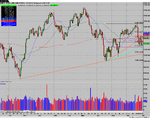roguetrader
Senior member
- Messages
- 2,062
- Likes
- 49
Indu
After last weeks sharp late week selloff, Monday gave some follow through and took the index to within 3 points of 10,250, the level I and some others had listed as a potential support. From there the index put in an impressive bounce with a triple digit gain on Tuesday, but as was pointed out at the time, the lack of volume cautioned against seeing it as anything more than a bounce. After a brief follow through Wednesday the caution proved well founded as the sellers stepped in to take control. Thursday saw an opening gap up which immediately attracted sellers and the index sold off ahead of the FOMC announcement. The Fed announced a 1/4 point increase as expected and maintained their "measured pace" wording, that suggests further increases. The market promptly sold off with volume again increasing for a triple digit loss. A small bounce Friday leading into the weekend saw the Index finish fractionally higher for the week.
Looking forward to next week sees us in a similar situation to last week.
To the downside we have 10,250 area, which marks a late April swing high and the 61% fib retrace of the move up. This area provided support last week, can it do it again? Below that I have a trendline (ohlc) from the April low at about 10,230, followed by a swing low from mid-May, closing price of 10,140 which coincides with the 78.6% fib ret. which also ties in fairly closely with a trendline from late Oct. Beyond that is 10,048 as the low of the first selloff attempt after the bounce from the April lows.
To the upside, 10,398, current location of the 50 day sma, this area proved resistance on an intraday basis last week and is also linked to a swing high from early May and really extends to 10,433 which is the swing high of the last bounce from 250. Followed by 10,445 which is the current location of the 200 day sma Essentially the INDU has a lot of overhead all in close proximity and any advance from here would be impressive.
After last weeks sharp late week selloff, Monday gave some follow through and took the index to within 3 points of 10,250, the level I and some others had listed as a potential support. From there the index put in an impressive bounce with a triple digit gain on Tuesday, but as was pointed out at the time, the lack of volume cautioned against seeing it as anything more than a bounce. After a brief follow through Wednesday the caution proved well founded as the sellers stepped in to take control. Thursday saw an opening gap up which immediately attracted sellers and the index sold off ahead of the FOMC announcement. The Fed announced a 1/4 point increase as expected and maintained their "measured pace" wording, that suggests further increases. The market promptly sold off with volume again increasing for a triple digit loss. A small bounce Friday leading into the weekend saw the Index finish fractionally higher for the week.
Looking forward to next week sees us in a similar situation to last week.
To the downside we have 10,250 area, which marks a late April swing high and the 61% fib retrace of the move up. This area provided support last week, can it do it again? Below that I have a trendline (ohlc) from the April low at about 10,230, followed by a swing low from mid-May, closing price of 10,140 which coincides with the 78.6% fib ret. which also ties in fairly closely with a trendline from late Oct. Beyond that is 10,048 as the low of the first selloff attempt after the bounce from the April lows.
To the upside, 10,398, current location of the 50 day sma, this area proved resistance on an intraday basis last week and is also linked to a swing high from early May and really extends to 10,433 which is the swing high of the last bounce from 250. Followed by 10,445 which is the current location of the 200 day sma Essentially the INDU has a lot of overhead all in close proximity and any advance from here would be impressive.



